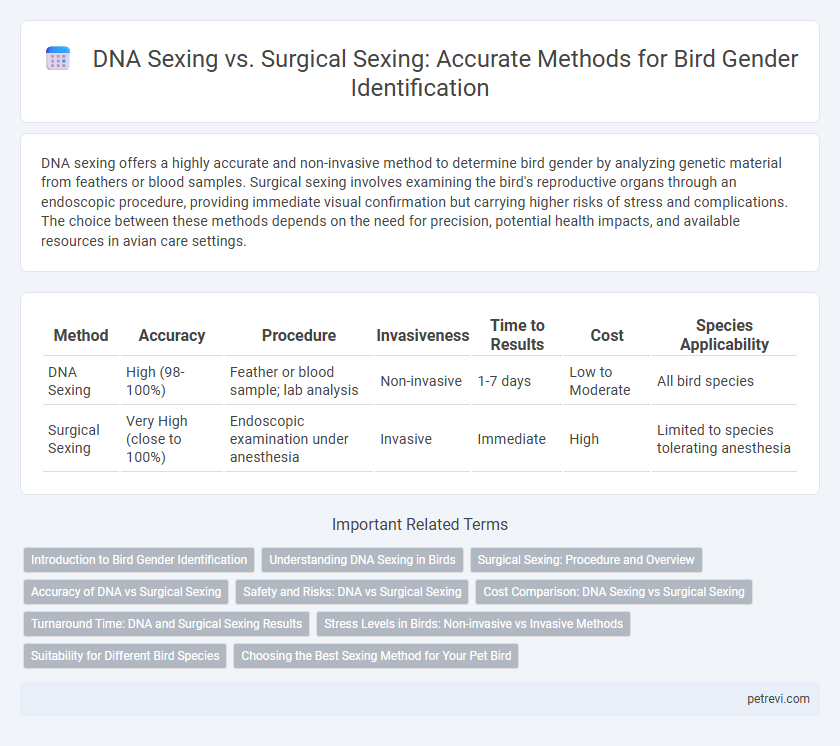DNA sexing offers a highly accurate and non-invasive method to determine bird gender by analyzing genetic material from feathers or blood samples. Surgical sexing involves examining the bird's reproductive organs through an endoscopic procedure, providing immediate visual confirmation but carrying higher risks of stress and complications. The choice between these methods depends on the need for precision, potential health impacts, and available resources in avian care settings.
Table of Comparison
| Method | Accuracy | Procedure | Invasiveness | Time to Results | Cost | Species Applicability |
|---|---|---|---|---|---|---|
| DNA Sexing | High (98-100%) | Feather or blood sample; lab analysis | Non-invasive | 1-7 days | Low to Moderate | All bird species |
| Surgical Sexing | Very High (close to 100%) | Endoscopic examination under anesthesia | Invasive | Immediate | High | Limited to species tolerating anesthesia |
Introduction to Bird Gender Identification
DNA sexing for birds relies on analyzing genetic material from feathers or blood, providing accurate and non-invasive gender identification. Surgical sexing involves endoscopic examination to visually inspect reproductive organs, offering immediate results but with increased risk and stress for the bird. DNA sexing is preferred for its precision and minimal impact, especially in species with no external dimorphism.
Understanding DNA Sexing in Birds
DNA sexing in birds relies on analyzing specific genetic markers from a small blood or feather sample to accurately determine gender, offering a non-invasive and highly reliable method. This technique targets the CHD gene located on the Z and W sex chromosomes, allowing clear differentiation between male (ZZ) and female (ZW) birds. Compared to surgical sexing, DNA sexing reduces stress and risk to the bird while providing precise results even in species with minimal sexual dimorphism.
Surgical Sexing: Procedure and Overview
Surgical sexing of birds involves a small incision to visually examine the gonads, providing a definitive and accurate gender identification method. The procedure requires anesthesia and is typically performed by a trained avian veterinarian, minimizing stress and risk to the bird. This technique is more invasive than DNA sexing but offers immediate results and is especially useful for species where DNA testing is less reliable.
Accuracy of DNA vs Surgical Sexing
DNA sexing offers a higher accuracy rate of over 99% in determining bird gender by analyzing genetic markers, whereas surgical sexing accuracy depends on the skill of the veterinarian and can vary between 90-95%. Surgical sexing involves invasive endoscopy to visually inspect reproductive organs, carrying potential risks and errors due to anatomical variances. DNA sexing remains the preferred method in avian gender identification due to its non-invasive nature and consistent precision across diverse bird species.
Safety and Risks: DNA vs Surgical Sexing
DNA sexing of birds offers a highly safe and non-invasive method for gender identification, relying on a simple blood or feather sample that poses minimal risk of stress or injury. Surgical sexing involves endoscopic examination, which carries inherent risks such as infection, anesthesia complications, and physical trauma to delicate organs. Therefore, DNA sexing is widely preferred for its negligible safety risks and accuracy compared to the more invasive and risk-prone surgical approach.
Cost Comparison: DNA Sexing vs Surgical Sexing
DNA sexing for birds generally involves a lower upfront cost ranging from $15 to $40 per sample, making it a more affordable and non-invasive choice compared to surgical sexing, which can cost between $150 to $300 due to anesthesia and veterinary fees. Surgical sexing, while offering immediate and visually confirmable results, incurs higher costs related to equipment, skilled personnel, and longer recovery time. DNA sexing is cost-effective for large numbers of birds and reduces risk, whereas surgical sexing may be justified when absolute certainty is required despite the higher expense.
Turnaround Time: DNA and Surgical Sexing Results
DNA sexing for birds typically delivers results within 24 to 72 hours, offering a rapid and non-invasive method for gender identification. In contrast, surgical sexing requires anesthesia and recovery time, often extending turnaround to several days and increasing stress on the bird. The faster processing of DNA sexing provides a practical advantage in breeding programs and wildlife research where timely decisions are critical.
Stress Levels in Birds: Non-invasive vs Invasive Methods
DNA sexing in birds offers a non-invasive technique that significantly reduces stress by using feather or blood samples without physical harm. Surgical sexing, involving invasive procedures like endoscopy, elevates stress levels due to anesthesia and physical manipulation. Studies indicate that lower cortisol levels in birds undergoing DNA sexing improve overall welfare compared to the elevated stress biomarkers observed post-surgical intervention.
Suitability for Different Bird Species
DNA sexing offers high accuracy and is suitable for a wide range of bird species, including those with no obvious sexual dimorphism, such as parrots and finches. Surgical sexing, involving endoscopy, is more invasive and generally reserved for larger birds like raptors and waterfowl where internal reproductive organs are easily accessed. For small or delicate species, DNA sexing is preferred due to minimal stress and non-invasive sample collection.
Choosing the Best Sexing Method for Your Pet Bird
DNA sexing offers a non-invasive, highly accurate method for determining bird gender by analyzing feathers or blood samples, making it ideal for delicate or rare species. Surgical sexing, involving endoscopic examination, provides immediate and precise results but carries higher risks and requires anesthesia, limiting its use primarily to experienced veterinarians. Evaluating factors like bird species, health condition, cost, and the need for accuracy helps pet owners choose the most suitable sexing method.
DNA sexing vs Surgical sexing for Bird gender identification Infographic

 petrevi.com
petrevi.com